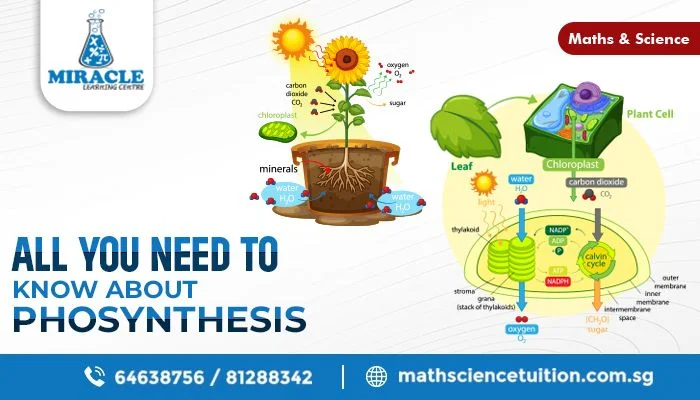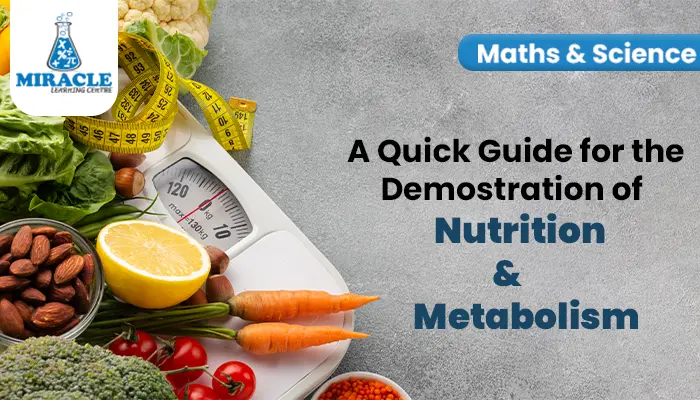Photosynthesis, a vital process that sustains life on Earth, is the fundamental mechanism by which plants, algae, and some bacteria convert sunlight into energy-rich organic compounds, primarily glucose. This remarkable process not only drives the growth and development of green organisms but also plays a critical role in regulating the planet's atmospheric composition.
We, at Miracle Learning Centre, believe that understanding the intricacies of this remarkable process is crucial for fostering a deeper appreciation of the natural world. Our science tuition in Singapore aims to enlighten students about the wonders of photosynthesis and its significance in shaping the delicate balance of life on our planet. From the intricacies of its molecular machinery to its global significance, this comprehensive exploration will delve into everything about photosynthesis.
What is Photosynthesis?
Photosynthesis, derived from the Greek words "photo" (light) and "synthesis" (to make), is a complex biological process that converts light energy into chemical energy. This process takes place in specialized cellular structures called chloroplasts in plants and algae, and in specialized regions of certain bacteria. The central objective of photosynthesis is to synthesize glucose, a simple sugar, from carbon dioxide (CO2) and water (H2O) using the energy from sunlight. The chemical equation for photosynthesis is as follows:
6 CO2 + 6 H2O + light energy → C6H12O6 (glucose) + 6 O2
The Photosynthetic Apparatus:
Photosynthesis involves a series of complex reactions occurring in two major stages: the light-dependent reactions and the light-independent reactions (Calvin cycle). In the light-dependent reactions, light energy is absorbed by chlorophyll molecules, located in the thylakoid membranes of the chloroplasts.
This energy is then used to split water molecules into oxygen (O2) and protons (H+), releasing electrons in the process. The electrons are subsequently passed along an electron transport chain, generating a proton gradient across the thylakoid membrane. The flow of protons back into the stroma of the chloroplast via an enzyme called ATP synthase generates adenosine triphosphate (ATP), the primary energy carrier in cells.
The Role of Pigments in Photosynthesis:
Photosynthetic pigments, such as chlorophyll, carotenoids, and phycobilins, absorb light at specific wavelengths. Chlorophyll, the primary pigment responsible for capturing light energy in photosynthesis, exists in different forms, with chlorophyll-a and chlorophyll-b being the most common types found in plants. These pigments absorb light in the blue and red regions of the electromagnetic spectrum while reflecting green light, which gives plants their characteristic colour.
If any student is interested in delving deeper into the fascinating world of light and photosynthetic pigments, they should engage in our science tuition in Singapore to access a comprehensive resource on the subject.
At Miracle Learning Centre, our science tuition in Singapore offers engaging and comprehensive lessons on topics like photosynthesis, helping students grasp the intricate details of this crucial biological process. Through our expert guidance and interactive learning methods, we aim to nurture a deep appreciation for science and inspire students to unlock their full potential in this exciting field.
Where does Photosynthesis occur?
Photosynthesis primarily occurs in the chloroplasts of plant cells, particularly in the leaves. Chloroplasts contain chlorophyll, the pigment responsible for capturing sunlight during the photosynthesis process.
The Factors of affecting Photosynthesis:
Several critical factors influence the efficiency of photosynthesis:
- Light Intensity:
Light intensity plays a crucial role in photosynthesis. Higher light levels can accelerate the process, but beyond a certain point, the rate plateaus as plants reach their light saturation point.
- The concentration of CO2:
CO2 availability affects the rate of photosynthesis. An increase in CO2 concentration enhances the process, up to a certain threshold where other factors become limiting.
- Temperature:
Photosynthesis is temperature-dependent, with an optimal range of around 20-30°C. Extreme temperatures can hinder the process and damage the plant's enzymes.
- Water:
Water is essential for the photosynthesis process. It is absorbed through the roots and transported to the leaves, where it is split during the light-dependent reactions.
- Pollution:
Pollutants in the air can negatively impact photosynthesis by interfering with the absorption of sunlight or affecting the stomata, which are responsible for gas exchange.
Types of Photosynthesis:
There are three primary types of photosynthesis:
- C3 photosynthesis:
C3 photosynthesis is the most common type, and it occurs in the majority of plants. In this process, the first stable compound formed during carbon fixation contains three carbon atoms.
- C4 photosynthesis:
C4 photosynthesis is adopted by certain plants, mainly in hot and arid conditions. These plants have specialized anatomy to minimize water loss and increase photosynthetic efficiency.
- CAM photosynthesis:
CAM photosynthesis is unique and found in succulent plants like cacti. They open their stomata at night to conserve water and fix carbon dioxide, which is then used during the day for photosynthesis.
If you want to learn more about all types of photosynthesis in detail join our science tuition program. At Miracle Learning Centre, our comprehensive science tuition empowers students to comprehend the nuances of photosynthesis and its various types, nurturing a deeper appreciation for the wonders of the natural world.
Process of Photosynthesis:
Photosynthesis involves two main stages:
Light Reaction:
- Light is absorbed by chlorophyll, exciting electrons and generating ATP and NADPH.
- Water is split, releasing oxygen as a byproduct.
Calvin Cycle:
- CO2 from the atmosphere is fixed into organic compounds using ATP and NADPH generated in the light reaction.
- Glucose and other carbohydrates are synthesized, supporting plant growth.
Miracle Learning Centre provides exemplary science tuition in Singapore, guiding students to unlock the marvels of photosynthesis. Our expert educators offer comprehensive lessons to nurture young minds and foster a passion for science.
Conclusion:
Photosynthesis is a remarkable process that sustains life on our planet. Understanding its intricacies is essential, and with expert science tuition in Singapore at Miracle Learning Centre, students can grasp the wonders of this natural phenomenon. As we continue to unravel the complexities of photosynthesis, we gain deeper insights into the delicate balance of nature and our responsibility to preserve it for future generations.








